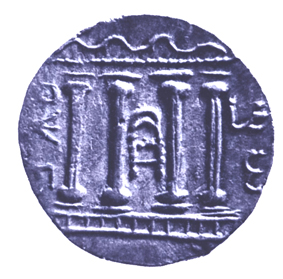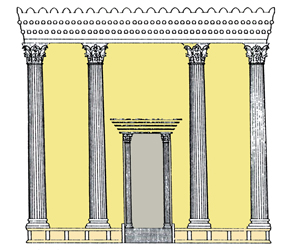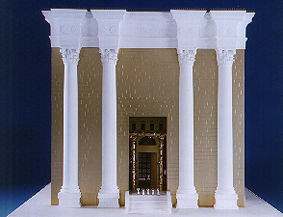A large cache of rare coins has been found by archaeologists in the Judean Hills. “Leaders of the Jewish resistance imprinted and dated coins for each year of the rebellion with, for example, images of the exterior of the Second Temple in Jerusalem and poetry for reclaiming Jerusalem as a means for spreading the rebellion via currency.”
Of special interest is the coin shown in the Jerusalem Post report, which dates from the third year of the Maccabean revolt. The Temple coins show a facade with four columns, a foundation course, a central entrance and a wavey line on top, perhaps representing the entablature. It was clearly an indication that the Jewish rebels against the Roman domination wanted to rebuild the Temple, once their freedom was regained. I once used a similar coin to reconstruct the facade of the Temple for an Israeli scholar and later used the information to design a reconstruction model of the Temple.

A Bar-Kokhba coin of year 3 showing the facade of the Temple

The reconstruction drawing of the Temple facade is based on the coin’s image

A reconstruction model showing the facade of Herod’s Temple

I agree with your interpretation- it’s the most obvious- but was just wondering what you thought of some other theories I’ve seen about the coin:
a) That the object in the center is the Holy Ark. (Which, of course, was not in the Second Temple, but this is an idealized picture.)
b) Possibly in conjunction with a), that the overall image is of the showbread table.
According to Dan Barag, the object in the center is the Table of Shewbread, viewed from its long side, see Ancient Jerusalem Revealed, p. 272-6. It cannot be the Ark of the Covenant, as you rightly said.
Hello,
I have been working recently in this area of study. I indicated this in an earlier note to you. I have not yet reached a place where I can send you the manuscript I said I would send, but I thought I should comment a little on the Temple design on the coin. Specifically I suspect the Ark had a triangular shape for the back of its cover. I think I can see this on some photos of coins from the Bar Kochba era. More importantly, this shape would fit a tent shape better. and it does fit a certain shape I found in the constellation I mentioned in my last note. The clue that led to this idea is in the description of the cherubs on the Ark where they are required to face the chest of the Ark as well as each other. This would work if their faces were attached as weere the faces of Adam and Eve in a certain legend in Legends of the Jews by Ginzburg, and if they then were on the back of the Ark cover. That is, they were side by side on a triangular board with their faces part of each other like may be seen in the Roman god Jamice. This same thing was found by me in the field at the site I have been investigating.
James
James,
The object in the doorway has a semi-circular top, not tri-angular. As mentioned in my reply to Nachum, it cannot be the Ark of the Covenant, but represents most likely the Table of Shewbread.
Hello,
I think you are correct. The Ark in any case was covered by a veil. I looked recently at the first page of a copy of the Zohar and on it there is a similar shape for the front of the Temple. The arch shape in that drawing was definately part of a door way and not the Ark.
see it at: http://en.sidipedia.org/wiki/File:Aohar.png
I, of course, have not seen the Ark. The triangular shape for the back of the cover is merely my idea of how it might look. I will explain thin in the manuscript. Presently the work I am doing involves the way the features on the Temple Mount fit the sky at the location of a feature in the constellation Cygnus in the years 3760 BC asd 2204 BC. These are the traditional dates for the creation and the Flood of Noah. The way the constellation fits the Temple Mount at around sunrise on the Spring Equinox in the year of the Creation has a feature called the Cygnus veil falling in the center of the Dome of the Rock. A certain part of the Cygnus veil that looks a bit like a chest with a triangualr shaped back falls very close the rectangular shape that you describe in your work as a possible place where the Ark was setting in the Temple of Solomon. This for me was interesting, but not conclusive. It would imply that the Temple Mount platform was designed with its long axis orientated toward the date (3769 BC) of the Creation. That is, the direction in 3760 BC on a conic projection of the sky over Jerusalem on that date. The projections I used for this study were forst for the spring equinox at sunrise and at one hour before sunrise. At sunrise with the sun just peeking over the horizon circle of the projection, the Cygnus Veil (also called the Cygnus Loop) falls on the center of the Dome of the Rock. At one hour before before sunrise on the same diagram the same Cygnus Veil (Loop) falls exactly on the center of the Dome of the Chain. This is interesting because, if the north south line is drawn south from the Dome of the Chain, it goes to the Double Gate. (That is, you put the North Pole of the conic projection at the Double Gate and the Cygnus Loop at the Dome of the Chain). Also, when the Cygnus Loop is placed at sunrise on the conic projection of the sky for the year 2204 BC, the traditional date according to the Jewish traditions for the Flood of Noah, it falls exactly on the Dome of the Chain. I think there is something about the telling of time of the sunset and sunrise at the Qumran site when anciently a black and white thread were compaired. I am not certain about this practice and whether or not an hour could be determined accurately from the positions of the stars in the Cygnus Constellation over Jerusalem, but I suspect that this process has something to do with the positions of the Dome of the Rock and the Dome of the Chain positions.
There are other things I think are worth mentioning about the Ark shape in the Cygnus Loop. It is at the emd of what looks like a dagger or knife shape. The dagger is being held in the right hand and arm of an ugly looking bearded man (the shape of a bearded man can be seen in the shape of the gas cloud that makes up the Cygnus Loop). This would be meaningless and merely a sport of nature like say the Man in the Moon that some people think they can see, if it were not for the story told about King David. You may recall that in the scriptures David saw a vision in the sky over Jerusalem of an Angel holding a sword or knife at the time when thousands of people were killed at the time of harvest. I think this must have been at the barley harvest, because at about that time when the passover was being celebrated the Cygnus Veil and its angel with a dager shape would have been exactly overhead, and exactly one hour after sunrise it would have passed over the Dome of the Rock. Not only that, the chest shape with the triangular shaped back would have passed through the site where you though the Ark may have been placed in Solomon’s temple. There are a number of consequences to this theory, if it is correct. I will mention one:
When I plot the dates of the major events in Jewish traditions I find a reason to suspect that the Arm of the Lord that is credited for causing powerful events may actually be a reference to the Cgynus Veil figure of the angel with a dagger. This applies to the events of the Creation, Flood, David’s vision, the destruction of the Assyerian Army at the Gates of Jerusalem, the birth of Jesus, the Bar Kochba event when 24,000 scholars were killed by the croup (so called), and to the vision at Mecca on which the writings of Islam are based. Afterward there are certain Jewish Messiahs and certain appearances of the Angel Michael that appear to apply to the same scheme. What I think I have found is a process that indicates that the Veil becomes brignt on a Log Log plot of intensity verses time. Each appearance seems to be or a lesser energy, and at a somewhat shorter interval. Presently the Cygnus Loop is quite dim. You have to use a camera with long exposier times to see it, and the chest shape I mentioned is a very dim part of it. It is there, you just have to find the right image to see it. I will explain this better I hope in the manuscript.
Thanks for your comments about the coin. I was drawn to the coin because of the star shape on it. I was thinking the star might be a reference to the bright appearance of the Cygnus Loop over the temple rather than the prophecy of a star in the scriptures. I suspect the Star of the prophecy was known to appear at certain times, and thus there was some kind of calculation that could be made by those in the know as to when the Messiah might appear. Thus it is said of Jesus and Bak Kochba that they were expected. In fact some of the later Messiahs claimed their qualifications to be Messiah was based on calculations. This might be explianed as happening in times when there was more dust in the atmosphere or when the Cygnus Veil didn’t have enouth energy to be noticed. This theory needs more work. It also needs a mechanism to explain how a perodic birghtening might happen. Thus far I am thinking a Jet from the star Cygnus X3 might be the source of the perodic nature of the bright phase of the Cygnus Loop.
JP
Hello,
I thought I should continue a bit more with the first note about the coin. The star on the coin is above the temple, and directly above the temple in the sky is the place called the zenith. In the year of the Flood of Noah according to Jewish tradition at dawn on the Spring Equinox, the star at the Zenith was Cygnus X3. It is about in the center of the Cyngus Bird shape. Similarly, one hour before sunrise on the Spring Equinox in the year of the Creation according to Jewish Tradition, the same Cygnus X-3 was also at the Zenith.
I mentioned in the first note that I thought the cover of the Ark had a back that was triangular shaped. I found some years ago some very good reasons for thinking this, but these reasons would best be described at a later time as they are quite complicated. However there are consequences to be considered if the Ark should have a triangle shape for a back cover. I will describe two related things in this note: The decorations above the opening of the Talpot Tomb and the Hooked X of the Templers. Both these subjects are described in detail in recent literature. I wish for now not to be included directly in public debate about them, as they are tangent to my present interests.
Please focus first on the roof of the structure on the coin. The crenulations there remeided me of the so called crown around the top of the cover for the Ark. Now think about the time when the Talpot Tomb was supposedly occupied. If it was about at the time of Jesus, then because his birth was associated with a star or light in the sky, it might be appropriate to ask how the Maji knew that the King of the Jews (so called) had arrived, and not the king of some other culture. I suspect it was because Cygnus X-3 was bright for a short time and because that star had previously been inportant to the Temple in Jerusalem. Therefore perhaps the circle on the Talpot Tomb entrance decoration represents the same star shape on the Coin. In that case the triangle shape would be that of the back of the Ark. Provided, that is, that the chest of the Ark is represented by the Temple Structure on the Coin. This would lnot be the only pyramid or triangular shape to be associated with a tomb, as there is a famous large one capping a tomb just below the Temple Mount that I am sure you must have seen. This brings me to the Hooked X shape. You will need to look at the triangular shape above the circle of the Talpot Tomb. Please seperate the two sides of the triangle then cross them so that you have made an Z shape of them. The hook on the upper right side of the X is very much like that of the hook on a Templer Hooked X. I doubt that this symbology has been found by others before me, and perhaps no one else has connected it to the coin of Bar Kochba and the Ark before. If they had, I think it would make the next part easier to believe. The Hook on the Hooked x of course is exactly at the location of the Ark shape in the Cygnus Loop mentioned earlier. Also the acale (diameter) of the circle fits pretty well with that of the star on the coin. Just transfer the Talpot triangle and circle so that it sets above the Temple on the coin and you would then have a picture something like I have been thinking about for some years now for the Ark. This is important for me to say this now because if the Ark should ever be found it might otherwise not be recognized as actually being the true Ark. There are a number of other things about the triangle shape that will be in the manuscript.
Presently the manuscript is in two parts. Part I is about half finished and in poor arrangement. Part II is complete, but it needs a little work in arranging the last few sections to make it easier to follow. It is quite complicated, as I attempt to follow the history of the subject site for several thousand years. I am also near publishing a novel that deacribes something about the supposed very early history of the subject site. I am in discussions presently with a possible translator of the novel. I wanted it to be in Hebrew.
Thanks for your reply,
JP
I don’t know how you get from the Bar Kokhba coin Temple to the reconstruction below ?
If there’s no any interest ? Here is the Temple depicted on the Bar Kokhba coin.
http://www.kean.edu/~jtuerk/images/1_CompMedieval/3_Synagogues/11.jpg
Dura Europas synagogue Syria
I thlought there were two bronze piilers in front of the temple. This is mentioned in first Kings. ??? I have a 132 coin.
Solomon’s Temple had indeed two pillars, but the Second Temple had four.
I would suggest that it looked like the Hadrian-Arch-in-jerash, and from all the models i have seen none look like it! w i think thy?hat with todays ability with 3D programs, it should be possible to make it exact replica looking.
It is difficult to compare a gate with a temple. Hadrian’s Arch in Jerash is a triple gate, while the Temple had only one gate. I have used the design of Hadrian’s Arch in the reconstruction of the Roman Damascus gate in Jerusalem.
Dear mr Ritmeyer,
do you have a maquette of Jerusalem from the time of Nehemiah? (I already purchased your book on this subject)
Yours sincerely,
Tony Jonathan
Arnhem, Holland
Tony,
The large model of Jerusalem in the time of Nehemiah was made in Australia. I have no other model available.
Does the Bar Kochba coin show a vaulted entrance rather than a square on as depicted in the models?
Joachim,
According to Prof. Dan Barag, the arched installation on the coin is a side view of the Table of Shewbread.
I think that this facade would fit very nicely to be the original view.
http://guildofbezalel.blogspot.com/2011/01/hcsbsb-herods-temple-exterior-view.html
elija,
It’s better but it’s to big ! And the portal depicted on the Bar-Kokhba coin, was a scallop shell.
Like this > http://i43.tinypic.com/316w411.jpg
Temple on Beit She’arim sarcophagus > http://i43.tinypic.com/m79yjl.jpg
Temple on Dura-Europus wall > http://i44.tinypic.com/j5fmgh.jpg
All modern models are depicting the facade of Herod’s Temple wrong
your reconstruction is amazing.
I have a query.
Why did you decide to place the outermost columns of the facde away from the corners?